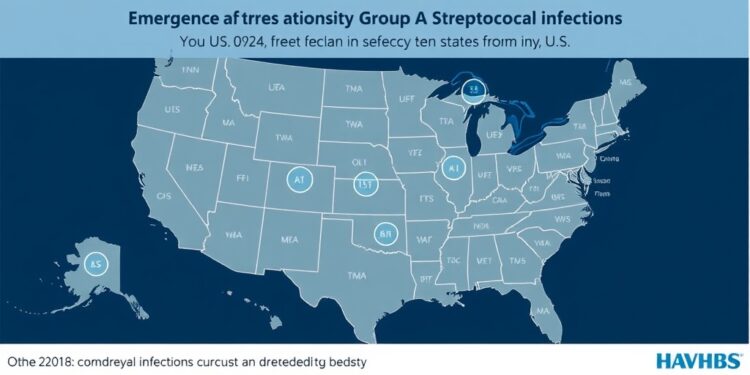Invasive group A Streptococcus (iGAS) infections have demonstrated a troubling increase across various regions of the United States, presenting a crucial public health concern. Between the years 2013 and 2022, healthcare professionals observed a particularly significant uptick in these infections in ten specific U.S. states. This alarming trend underscores the pressing need for enhanced measures aimed at preventing and controlling group A Streptococcus infections, especially among populations that are considered at an elevated risk of severe outcomes.
The increase in iGAS cases is not merely statistical; it translates to real individuals and families facing severe health threats. Group A Streptococcus, known scientifically as Streptococcus pyogenes, is a bacterium often associated with mild illnesses but can lead to life-threatening conditions such as necrotizing fasciitis and toxic shock syndrome when invasive. This dual nature of group A Streptococcus complicates public health messaging, as many individuals may not recognize the severity of the illness until it is too late.
Healthcare professionals, public health officials, and researchers alike are now tasked with addressing this worrisome trend by not just responding to outbreaks but also proactively educating the community about the signs and symptoms of severe infections. Increased awareness is particularly critical in vulnerable populations, including the elderly, individuals with chronic health conditions, and children, as they harbor a higher susceptibility to the most severe consequences of such infections.
The CDC has initiated several campaigns to boost public understanding of the risks associated with group A Streptococcus. These campaigns focus on promoting hygiene practices, such as handwashing and the proper care of wounds, which are essential components of infection control. Synergizing these public health education efforts with heightened surveillance and rapid response mechanisms are key strategies that can mitigate the growing threat posed by invasive group A Streptococcus infections.
Further, the community must collectively engage in disease prevention strategies. Healthcare providers play a pivotal role in monitoring cases and disseminating information that empowers patients. The greater understanding of the infection could foster an environment where individuals are more inclined to seek medical attention promptly upon noticing the first signs of an illness. The importance of timely diagnosis and intervention has never been clearer, as early treatment can significantly reduce the risk of severe complications associated with iGAS.
Research into the epidemiology of these infections reveals critical insights into the patterns, transmission, and risk factors associated with group A Streptococcus. Advancements in molecular techniques and genomic epidemiology have enabled researchers to track strains of the bacteria, providing invaluable data that can inform public health initiatives. As the scientific community delves deeper into these findings, the hope is that more effective preventative measures and treatment protocols will emerge.
In tandem with these advances, the significance of vaccination cannot be understated. While no vaccine currently exists specifically for group A Streptococcus, ongoing research is investigating the feasibility of developing one. A successful vaccine could revolutionize how society manages the burden of these infections, effectively reducing their incidence and saving countless lives. The innovation landscape is ripe for vaccine development, which remains a critical frontier in the fight against invasive group A Streptococcus.
Antibiotic resistance is another vital consideration in this conversation. The rise of multi-drug resistant strains of bacteria poses significant challenges for healthcare providers. The presence of resistant strains complicates treatment strategies and increases the likelihood of severe outcomes from infections. Public health policies must consider the environmental impacts of antibiotic use and promote responsible prescribing practices among healthcare professionals.
Ultimately, community engagement will be instrumental in combating the rising tide of invasive group A Streptococcus infections. Families must be educated about the risks and informed about appropriate health-seeking behaviors. Schools, daycares, and community centers can serve as critical platforms for health education initiatives. This multifaceted approach calls for collaboration across various sectors to create a cohesive response to a growing health concern.
Public health systems are currently prioritizing the integration of technological advancements in surveillance and data reporting related to group A Streptococcus infections. By harnessing the power of data analytics, health departments can enhance their ability to conduct timely outbreaks, track infection rates, and allocate resources effectively. This real-time monitoring can enable proactive responses, potentially curtailing the severe impacts of these infections.
The long-term implications of the rise in iGAS infections must catalyze a reevaluation of public health infrastructure and resource allocation. It is imperative that adequate funding and support are directed toward research, health education, and preventive measures to combat these infections. As a society, there is a pressing need to prioritize infectious disease control and support initiatives that foster a healthier populace.
As we navigate this complex landscape of infectious disease threats, the urgency of addressing group A Streptococcus infections cannot be overstated. Collaborative efforts across public health, clinical practice, and community involvement represent our best chance of reversing the trends we currently observe. Everyone plays a role in this fight against infections that, despite their history, are becoming increasingly prevalent both in the United States and around the globe.
With continued vigilance and a commitment to understanding and controlling infectious diseases, we arm ourselves with the knowledge necessary to protect our communities. Advances in medical science, public health policy, and community education are crucial for tackling the challenges of group A Streptococcus. The path forward requires dedication and an unwavering commitment to public health optimization.
By fostering a cooperative environment that embraces research, education, and preventive practices, we can collectively mitigate the threat posed by invasive group A Streptococcus and pave the way toward a healthier future for all.
Subject of Research: Invasive group A Streptococcus infections
Article Title: Rising Trends in Invasive Group A Streptococcus Infections in the U.S.
News Publication Date: N/A
Web References: N/A
References: N/A
Image Credits: N/A
Keywords: Invasive group A Streptococcus, public health, infection control, disease prevention, antibiotic resistance, vaccination, healthcare awareness.




